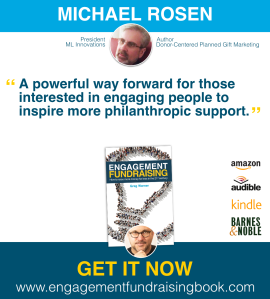I recently had the opportunity to spend some quality time with a major donor. He was kind enough to visit with my graduate students in the “Advanced Fund Development” class I teach at Drexel University. Daniel (not his real name) shared a number of valuable insights about how some philanthropists think.
I thought you might like to learn what Daniel had to say since it might very well help you when working with your own donors and prospects.
 Daniel and his wife personally contribute generously to a variety of nonprofit organizations and serve on a number of nonprofit boards. Daniel also administers a family foundation established by his parents.
Daniel and his wife personally contribute generously to a variety of nonprofit organizations and serve on a number of nonprofit boards. Daniel also administers a family foundation established by his parents.
Daniel told the class that he believes “donors see their giving as an extension of themselves.” He indicated that the more involved he is with an organization, the more personally he’s connected, the more likely he is to donate. In addition, he said that he is motivated by the notion of “giving back.” If he, or a family member, has benefited from the services of an organization in a significant way, he’s more likely to contribute.
However, for Daniel, it’s not all about involvement and reciprocity. He needs to also have confidence in an organization’s leadership before he’ll provide a significant gift. Two of the things that help build his confidence in the leadership are:
- the quality of the organization’s products or services,
- the demonstrated efficiency with which the organization provides those products or services.
One of his sources for information about organizational efficiency is Guidestar.
If an organization has a good relationship with a prospective donor, Daniel doesn’t really believe there’s much of risk in accidentally asking for too much. He says, “People aren’t really offended by being asked for too much if they were properly cultivated first.”
Daniel understands nonprofit organizations. He expects to be asked. If he’s asked for too much, he simply lets the development professional know. He doesn’t get offended because he assumes the development professional has made a good-faith attempt to ask for something appropriate. Sometimes they miss; sometimes they hit the target.
When discussing particularly large or complex gift arrangements, Daniel doesn’t rely on the expertise of his development contact. Instead, he turns to his lawyer for advice. While he wants his development contact to be knowledgeable, he has no expectation of or need for that person to be an expert in the area of complex gifting.
Organizations that approach Daniel should also understand that he and his wife consult each other before making philanthropic commitments. While they don’t necessarily support all the same organizations, they’re both involved in most philanthropic decisions.
When he gives, Daniel really doesn’t expect to receive any tangible benefits. Daniel says such benefits or little recognition gifts are not very important to him, though they’re sometimes nice. What’s more important to him is access. For example, when he contributes to a theatre company, he enjoys the opportunity to meet the actors and directors.
While Daniel likes having the option to meet with a development professional, to visit an organization’s home, or to observe its programs, he doesn’t usually require a lot of hand-holding before making a philanthropic decision because, in part, he doesn’t have the time for it.
“Someday, I may have more time, but I won’t necessarily want to spend it with a development person,” he says with a smile. He’s happiest when organizations respect his time while giving him the option of how much contact he will have.
Much of what Daniel shared with my students was nothing new. Researchers have found many donors feel the same way. But, his insights serve as terrific reminder for all development professionals.
When working with your major donors and prospects, keep these tips in mind:
read more »











 philanthropic decision. The sooner someone gives in response to an appeal, the more likely they are to give. People who set an appeal aside thinking they’ll get to it later, often do not.
philanthropic decision. The sooner someone gives in response to an appeal, the more likely they are to give. People who set an appeal aside thinking they’ll get to it later, often do not. When the Girl Scouts received the $100,000 gift, the staff was understandably thrilled. The money equaled approximately one-third of the organization’s financial assistance program budget for the year. The Girl Scouts offer financial assistance so that any girl can join despite economic obstacles.
When the Girl Scouts received the $100,000 gift, the staff was understandably thrilled. The money equaled approximately one-third of the organization’s financial assistance program budget for the year. The Girl Scouts offer financial assistance so that any girl can join despite economic obstacles.

